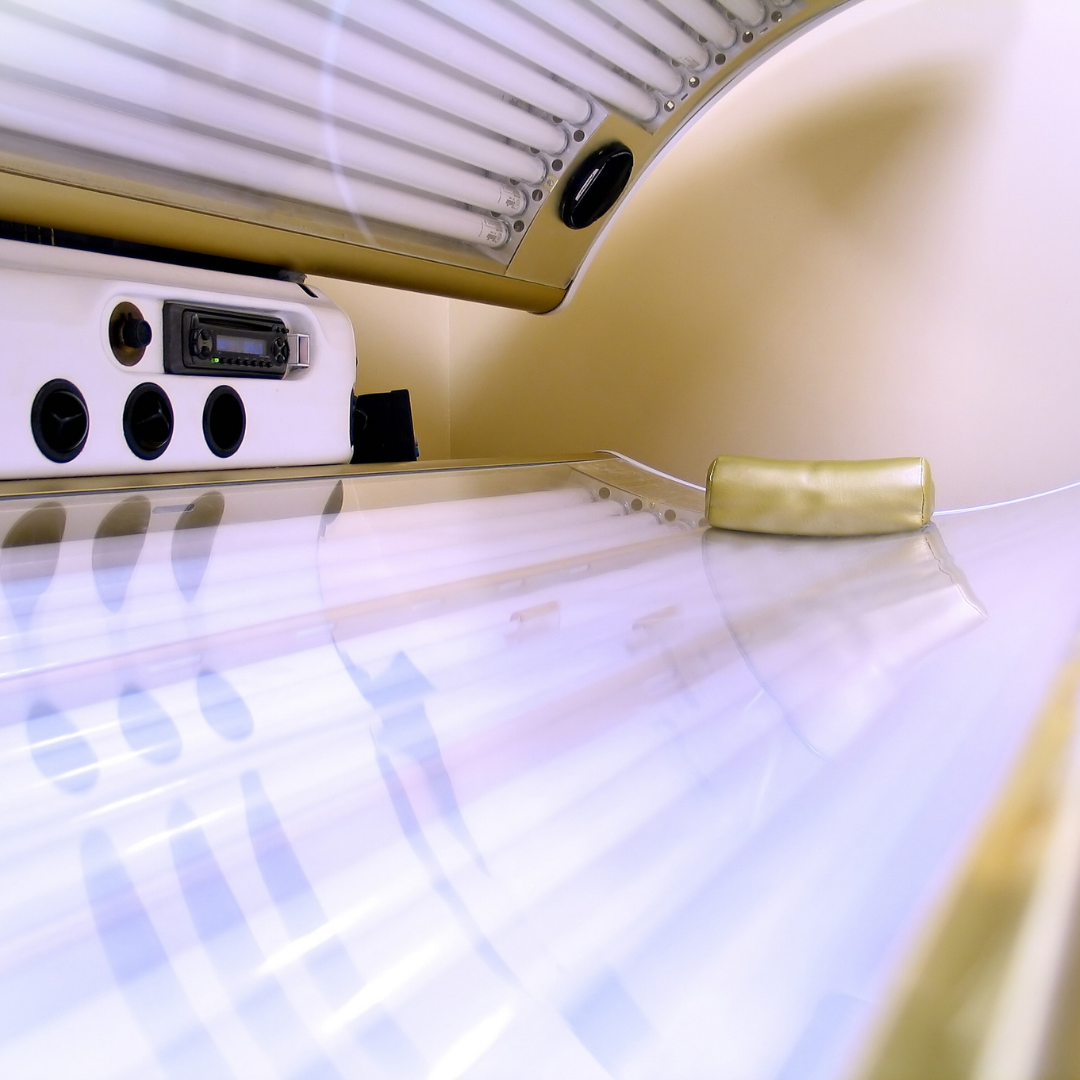Are tanning beds safe? Skincare myths busted!

We’ve all heard different claims about tanning beds, but what’s the truth? Are tanning beds safer than sunbathing? Do tanning beds increase vitamin D levels? And how can you be safest when you want to get a tan? In this post we’ll explore the science behind the myths and bring you the truth about tanning bed safety.
How do tanning beds work?

Tanning beds, or sunbeds, accelerate the effects of tanning by mimicking sunlight. The “tanning” component in light is ultraviolet (UV) light. UV light makes up about ten percent of sunlight, but a much higher percentage of the light emitted by sunbeds.
The amount of UV light in sunlight changes depending on the location, season, time of day, and weather. UV light is measured using the UV Index, which ranges from 0-11+. At noon in the summer in St. Louis, MO, for example, the UV index is around 9. In Anchorage, AK, the summer noonday UV index peaks at 4.
UV light is found just above visible light on the electromagnetic spectrum. There are three kinds of UV light — UVA, UVB, and UVC. UVA light is the closest to visible light, and has the longest wavelengths. UVC light has the shortest wavelength, and is closer to X-rays and gamma radiation. UVC light is the most dangerous to us, but we rarely come into contact with it. UVC light from sunlight is absorbed by the ozone layer, and sunbeds don’t produce UVC light at all.
The UV light from sunbeds, and from sunlight, are all around 95% UVA and 5% UVB. Some modern sunbeds produce only UVA light. This is the safest kind of UV light — but it still isn’t completely safe for our skin.
Are tanning beds safe?

3D structure of a melanoma cell from the National Cancer Institute
For a long time, scientists thought that UVA light wavelengths couldn’t penetrate our skin, and only caused surface damage. UVA light is therefore most associated with signs of premature aging, such as wrinkles, dryness, and leathery skin texture. Today, however, there’s growing evidence that UVA light is a cause of melanoma, the most dangerous kind of skin cancer.
One study found that 97% of women who developed melanoma under 30 had used tanning beds. And another study showed that people who started using tanning beds in their teens or twenties were 75% more likely to develop melanoma in their lifetimes.
That doesn’t mean it’s likely that you will ever get melanoma — the odds are about 2.6% for white people, 0.1% for Black people, and 0.6% for Hispanics — but the chances are significantly increased if you use sunbeds.
Do sunbeds help vitamin D deficiency?

We know that we can get vitamin D from sunlight, so you may have heard that tanning beds will boost your vitamin D levels. However it’s specifically UVB light that our bodies need to make vitamin D.
Vitamin D is essential for healthy bones and muscles, and is also important for our immune systems. However more and more people are becoming vitamin D deficient because we don’t get enough exposure to sunlight. Using sunscreen — which you should always do, even on cloudy days — can block UVB rays and prevent you getting enough vitamin D.
Some people think that sunbeds are the solution, but most modern sunbeds only emit UVA rays, which our bodies can’t use to make vitamin D. And even if you find a sunbed that does produce UVB light, you still risk damaging your skin, leading to signs of premature aging and maybe cancer. It’s much safer to get extra vitamin D through your diet or supplements. Good sources of vitamin D include oily fish, red meat, and eggs.
Does a base tan prevent sunburn?

A very common reason people use tanning beds is to get a “base tan” before heading off on vacation. There is some truth that a little UV light exposure can protect your skin from future exposure. UV light triggers melanin production, which is what gives us a tanned appearance.
Melanin is a protective pigment that helps shield our skin from harmful rays. However the protection we get from tanning is limited, and is only about the equivalent of SPF 4. It’s much safer to skip the sunbed and use sunscreen instead.
Final thoughts

Indoor tanning is extremely popular, but it’s very dangerous for our skin. Using tanning beds could even be more harmful than natural sunlight because the UV light sunbeds produce is much stronger. Even one tanning session can increase the risk of cancer substantially. Studies have found that tanning just once increases the chances of developing melanoma by 20%, squamous cell carcinoma by 67%, and basal cell carcinoma by 29%.
As well as increasing the risk of developing skin cancer, tanning also accelerates the rate of cell aging. For every second we are exposed to UV light, about 50-100 bonds break in our DNA. Our bodies can repair most of these breaks, but too many overwhelm our systems. The breaks that aren’t repaired can lead to cellular senescence or cell death. This causes cascading damage to surrounding cells that appears on our skin as age spots, discoloration, wrinkles, and rough patches.
If you love looking tan all year round, the safest way to do so is by using self-tanner. Tinted moisturizers, spray tans, and bronzing powder can all produce the same golden glow, without damaging your skin.